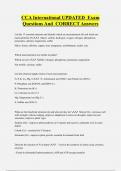College aantekeningen
Notes Food Related Allergies and Intolerances FCH-21806
Notes Food Related Allergies and Intolerances. The notes are quite extensive but contain all information needed to successfully pass the exam. The note also contain (parts of) lecture slides for better understanding of the course material.
[Meer zien]













